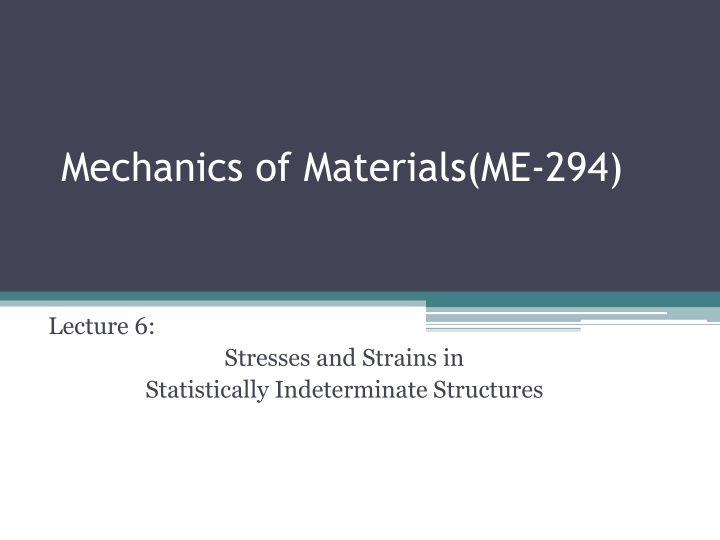
Stresses and Strains in Structurally Indeterminate Bodies
Understand the concepts of statically determinate and indeterminate structures in mechanics of materials. Learn how to analyze indeterminate bars using additional equations of equilibrium and compatibility. Discover the force-displacement relations in linearly elastic materials for solving complex structural problems efficiently.
Download Presentation

Please find below an Image/Link to download the presentation.
The content on the website is provided AS IS for your information and personal use only. It may not be sold, licensed, or shared on other websites without obtaining consent from the author. If you encounter any issues during the download, it is possible that the publisher has removed the file from their server.
You are allowed to download the files provided on this website for personal or commercial use, subject to the condition that they are used lawfully. All files are the property of their respective owners.
The content on the website is provided AS IS for your information and personal use only. It may not be sold, licensed, or shared on other websites without obtaining consent from the author.
E N D
Presentation Transcript
Mechanics of Materials(ME-294) Lecture 6: Stresses and Strains in Statistically Indeterminate Structures
Statically determinate structures If the values of all the external forces which act on a body can be determined by the equations of static equilibrium alone, then the force system is statically determinate Structures are classified as statically determinate if their reactions and internal forces can be determined solely from free-body diagrams and equations of equilibrium. Forces in a statically determinate structure can be found without knowing the properties of the materials. To analyze such structures we must supplement the equilibrium equations with additional equations pertaining to the displacements of the structure
The bar shown in Fig. is loaded by the known force P1 and P2. The reaction is R . The system is statically determinate because the R can be found using equations of static equilibrium ( F = 0, M = 0) The prismatic bar AB is attached to rigid supports at both ends and is axially loaded by a force P at an intermediate point C. As already discussed, the reactions RA and RB cannot be found by statics alone, because only one equation of equilibrium is available: F ver =0,RA+RB-P=0 (a)
Analysis of a statically indeterminate bar The additional equation is based upon the observation that a bar with both ends fixed does not change in length. If we separate the bar from its supports , we obtain a bar that is free at both ends and loaded by the three forces, RA, RB, and P. These forces cause the bar to change in length by an amount AB , which must be equal to zero: AB= 0 ..(b) This equation, called an equation of compatibility, expresses the fact that the change in length of the bar must be compatible with the conditions at the supports.
In order to solve Eqs. (a) and (b), we must now express the compatibility equation in terms of the unknown forces RA and RB. The relationships between the forces acting on a bar and its changes in length are known as force-displacement relations. If the material is linearly elastic, following equation can be used to obtain the force- displacement relations =PL/EA
Let us assume that the bar of Fig has cross-sectional area A and is made of a material with modulus E. Then the changes in lengths of the upper and lower segments of the bar are, respectively, where the minus sign indicates a shortening of the bar. Equations (c) and (d) are the force-displacement relations. We are now ready to solve simultaneously the three sets of equations (the equation of equilibrium, the equation of compatibility, and the force displacement relations). Combine the force-displacement relations with the equation of compatibility: Note that this equation contains the two reactions as unknowns.
The next step is to solve simultaneously the equation of equilibrium (Eq. a) and the preceding equation (Eq. e). The results are With the reactions known, all other force and displacement quantities can be determined. Suppose, for instance, that we wish to find the downward displacement c of point C. This displacement is equal to the elongation of segment AC: Also, we can find the stresses in the two segments of the bar directly from the internal axial forces (e.g., sACRA/APb/AL). General
General Comments Analysis of a statically indeterminate structure involves setting up and solving equations of equilibrium, equations of compatibility, force-displacement relations. Equilibrium equations relate the loads acting on the structure to the unknown forces (which may be reactions or internal forces) Compatibility equations express conditions on the displacements of the structure. Force-displacement relations are expressions that use the dimensions and properties of the structural members to relate the forces and displacements of those members.
General Comments In the engineering literature, various terms are used for the conditions expressed by the equilibrium, compatibility, and force-displacement equations. equilibrium equations are also known as static or kinetic equations; compatibility equations are sometimes called geometric equations, kinematic equations, or equations of consistent deformations; force-displacement relations are often referred to as constitutive relations (because they deal with the constitution, or physical properties, of the materials). For the relatively simple structures the preceding method of analysis is adequate. However, more formalized approaches are needed for complicated structures. Two commonly used methods, the flexibility method (also called the force method) and the stiffness method (also called the displacement method), will be discussed in detail on structural analysis later.
Problems-1 A horizontal rigid bar AB is pinned at end A and supported by two wires (CD and EF) at points D and F (Fig. ). A vertical load P acts at end B of the bar. The bar has length 3b and wires CD and EF have lengths L1 and L2, respectively. Also, wire CD has diameter d1 and modulus of elasticity E1; wire EF has diameter d2 and modulus E2. (a) Obtain formulas for the allowable load P if the allowable stresses in wires CD and EF, respectively, are 1 and 2. (Disregard the weight of the bar itself.) (b) Calculate the allowable load P for the following conditions: Wire CD is made of aluminum with modulus El =72 GPa, diameter dl = 4.0 mm, and length Ll= 0.40 m. Wire EF is made of magnesium with modulus E2 =45 GPa, diameter d2= 3.0 mm, and length L2 = 0.30 m. The allowable stresses in the aluminum and magnesium wires are l =200 MPa and 2 =175 MPa, respectively.
Problem-2 A solid circular steel cylinder S is encased in a hollow circular copper tube C (Figs. a and b). The cylinder and tube are compressed between the rigid plates of a testing machine by compressive forces P. The steel cylinder has cross-sectional area As and modulus of elasticity Es, the copper tube has area Ac and modulus Ec, and both parts have length L. Determine the following quantities: (a) the compressive forces Ps in the steel cylinder and Pc in the copper tube; (b) the corresponding compressive stresses s and c; and (c) the shortening of the assembly.
Different cases: Stresses in simple statically indeterminate structures Stresses in indeterminate structures supporting a load Stresses in composite structures of equal length Stresses in composite structures of unequal length Stresses in Nuts and Bolts
Quiz-2 Shear Stresses & Elastic Constants .chapter 6 Thermal Stresses . chapter 5






















